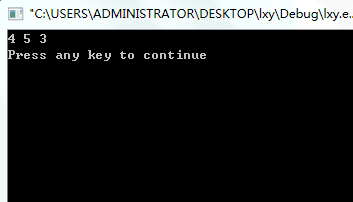问题及代码:
/*
*Copyright (c)2016,烟台大学计算机与控制工程学院
*All rights reserved.
*文件名称:111.cpp
*作 者:李晓钰
*完成日期:2016年9月17日
*版 本 号:v1.0
*
*问题描述:实现顺序表基本运算有算法,依据“最小化”的原则进行测试。所谓最小化
原则,指的是利用尽可能少的基本运算,组成一个程序,并设计main函数
完成测试。
*输入描述:无
*程序输出:依据各个函数而定
*/
(1)目的是要测试“建立线性表”的算法CreateList,为查看建表的结果,需要实现“输出线性表”的算法DispList。在研习DispList中发现,要输出线性表,还要判断表是否为空,这样,实现判断线性表是否为空的算法ListEmpty成为必要。这样,再加上main函数,这个程序由4个函数构成。main函数用于写测试相关的代码。
#ifndef LIST_H_INCLUDED
#define LIST_H_INCLUDED
#include <stdio.h>
#include <malloc.h>
#define MaxSize 50
typedef int ElemType;
typedef struct
{
ElemType data[MaxSize];
int length;
} SqList;
void CreateList(SqList *&L, ElemType a[], int n);//用数组创建线性表
bool ListEmpty(SqList *L);//判定是否为空表ListEmpty(L)
void DispList(SqList *L);//输出线性表DispList(L)
#endif
//测试函数
int main()
{
SqList *sq;
ElemType x[8]= {1,9,9,7,1,1,0,7};
CreateList(sq, x, 8);//最后为0则是空表
if((ListEmpty(sq))>0) //测试不能找到的情形
printf("是空表\n");
else
printf("不是空表\n");
DispList(sq);
return 0;
} //定义各个自定义函数
//用数组创建线性表
void CreateList(SqList *&L, ElemType a[], int n)
{
int i;
L=(SqList *)malloc(sizeof(SqList));
for (i=0; i<n; i++)
L->data[i]=a[i];
L->length=n;
}
//判定是否为空表ListEmpty(L)
bool ListEmpty(SqList *L)
{
return(L->length==0);
}
//输出线性表DispList(L)
void DispList(SqList *L)
{
int i;
if (ListEmpty(L)) return;
for (i=0; i<L->length; i++)
printf("%d ",L->data[i]);
printf("\n");
}
运行结果:
(2)在已经创建线性表的基础上,求线性表的长度ListLength、求线性表L中指定位置的某个数据元素GetElem、查找元素LocateElem的算法都可以实现了。就在原程序的基础上增加:
1.增加求线性表的长度ListLength的函数并测试;
2.增加求线性表L中指定位置的某个数据元素GetElem的函数并测试;
3.增加查找元素LocateElem的函数并测试;
#include <stdio.h>
#include <malloc.h>
#define MaxSize 50
typedef int ElemType;
typedef struct
{
ElemType data[MaxSize];
int length;
} SqList;
void CreateList(SqList *&L, ElemType a[], int n);
void DispList(SqList *L);
bool ListEmpty(SqList *L);
int ListLength(SqList *L);
bool GetElem(SqList *L,int i,ElemType &e);
int LocateElem(SqList *L, ElemType e);
int main()
{
SqList *sq;
ElemType x[8]= {1,9,9,7,1,1,0,7};
ElemType a;
int loc;
CreateList(sq, x, 8);
DispList(sq);
printf("表长度:%d\n", ListLength(sq));
if(GetElem(sq, 3, a))
printf("找到了第3个元素值为:%d\n", a);
else
printf("第3个元素超出范围!\n");
if(GetElem(sq, 15, a))
printf("找到了第15个元素值为:%d\n", a);
else
printf("第15个元素超出范围!\n");
if((loc=LocateElem(sq, 0))>0) //测试能找到的情形
printf("找到了,值为0的元素是第 %d 个\n", loc);
else
printf("值为0的元素没有找到!\n");
if((loc=LocateElem(sq, 11))>0) //测试不能找到的情形
printf("找到了,值为11的元素是第 %d 个\n", loc);
else
printf("值为11的元素没有找到!\n");
return 0;
}
void CreateList(SqList *&L, ElemType a[], int n)
{
int i;
L=(SqList *)malloc(sizeof(SqList));
for (i=0; i<n; i++)
L->data[i]=a[i];
L->length=n;
}
void DispList(SqList *L)
{
int i;
if (ListEmpty(L))
return;
for (i=0; i<L->length; i++)
printf("%d ",L->data[i]);
printf("\n");
}
bool ListEmpty(SqList *L)
{
return(L->length==0);
}
int ListLength(SqList *L)
{
return(L->length);
}
bool GetElem(SqList *L,int i,ElemType &e)
{
if (i<1 || i>L->length)
return false;
e=L->data[i-1];
return true;
}
int LocateElem(SqList *L, ElemType e)
{
int i=0;
while (i<L->length && L->data[i]!=e) i++;
if (i>=L->length)
return 0;
else
return i+1;
} 运行结果:
(3)其余的4个基本运算:插入数据元素ListInsert、删除数据元素ListDelete、初始化线性表InitList、销毁线性表DestroyList
#include <stdio.h>
#include <malloc.h>
#define MaxSize 50
typedef int ElemType;
typedef struct
{
ElemType data[MaxSize];
int length;
} SqList;
void CreateList(SqList *&L, ElemType a[], int n);
void DispList(SqList *L);
bool ListEmpty(SqList *L);
int ListLength(SqList *L);
bool GetElem(SqList *L,int i,ElemType &e);
int LocateElem(SqList *L, ElemType e);
bool ListInsert(SqList *&L,int i,ElemType e);
void InitList(SqList *&L);
int main()
{
SqList *sq;
InitList(sq);
ListInsert(sq, 1, 5);
ListInsert(sq, 2, 3);
ListInsert(sq, 1, 4);
DispList(sq);
return 0;
}
void CreateList(SqList *&L, ElemType a[], int n)
{
int i;
L=(SqList *)malloc(sizeof(SqList));
for (i=0; i<n; i++)
L->data[i]=a[i];
L->length=n;
}
void DispList(SqList *L)
{
int i;
if (ListEmpty(L))
return;
for (i=0; i<L->length; i++)
printf("%d ",L->data[i]);
printf("\n");
}
bool ListEmpty(SqList *L)
{
return(L->length==0);
}
int ListLength(SqList *L)
{
return(L->length);
}
bool GetElem(SqList *L,int i,ElemType &e)
{
if (i<1 || i>L->length)
return false;
e=L->data[i-1];
return true;
}
int LocateElem(SqList *L, ElemType e)
{
int i=0;
while (i<L->length && L->data[i]!=e) i++;
if (i>=L->length)
return 0;
else
return i+1;
}
//初始化线性表
void InitList(SqList *&L)
{
L=(SqList *)malloc(sizeof(SqList));
L->length=0;
}
//插入数据元素
bool ListInsert(SqList *&L,int i,ElemType e)
{
int j;
if(i<1||i>L->length+1)
return false;
i--;
for(j=L->length;j>i;j--)
L->data[j]=L->data[j-1];
L->data[i]=e;
L->length++;
return true;
} 运行结果:
知识点总结:通过手敲代码,对链表的创建、插入、删除、输出等功能进行了回顾,也锻炼了使用函数的能力。
学习心得:巩固了以前所学的链表知识,对其掌握的更加牢固。
























 917
917











 被折叠的 条评论
为什么被折叠?
被折叠的 条评论
为什么被折叠?








